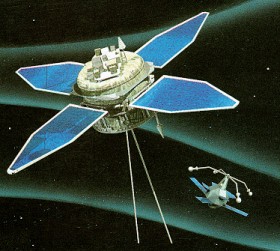INTERBALL
Space plasma mission
 The international Interball mission consists of four spacecraft
equipped by an international consortium and launched by the Russian
Space Agency. Two of the satellites, called INTERBALL-1, were launched
into a high apogee elliptical orbit around the Earth (apogee: 200 000
km) and two (INTERBALL-2) into an excentric polar orbit (apogee: 20
000 km over the northern hemisphere. Both pairs of satellites consist
of a Prognoz-type main satellite and a free-flying Magion-type Czech
subsatellite. Interball, along with the already launched
The international Interball mission consists of four spacecraft
equipped by an international consortium and launched by the Russian
Space Agency. Two of the satellites, called INTERBALL-1, were launched
into a high apogee elliptical orbit around the Earth (apogee: 200 000
km) and two (INTERBALL-2) into an excentric polar orbit (apogee: 20
000 km over the northern hemisphere. Both pairs of satellites consist
of a Prognoz-type main satellite and a free-flying Magion-type Czech
subsatellite. Interball, along with the already launched
 GEOTAIL, POLAR, WIND and SOHO, a
cornerstone project of the European Space Agency, as well as
GEOTAIL, POLAR, WIND and SOHO, a
cornerstone project of the European Space Agency, as well as
 EQUATOR-S are all spaceborn
contributions to the
EQUATOR-S are all spaceborn
contributions to the
 International Solar
Terrestrial Physics (ISTP) Science Initiative.
International Solar
Terrestrial Physics (ISTP) Science Initiative.
Interball, the tail probes, were launched on August 2, 1995 at 22:00
UT (or 01:00 on August 3, 1995 Moscow Time) from the Russian Plesetzk
launch site.
Science objectives
High latitude magnetopause observations
Using the highly excentric orbit of Interball the magnetic field
measurements of the German fluxgate magnetometer
FGM-1 during high latitude magnetopause crossings
were analyzed. The strong oscillations, observed during a period of
reular solar wind flow (i.e. without pressure pulses etc.) were
compared with MHD-simulations of a Kelvin-Helmholtz (KH) unstable
magnetopause current layer. The surface wave signatures produced by
MHD simulations remind the observed ones. This was used as an
indication of a KH unstable high-latitude magnetopause.
Magnetotail observations
INTERBALL-1 tail magnetic field observations of the fluxgate
magnetometer
 FGM-1 were compared with GISMO
three-dimensional fully kinetic electromagnetic particle simulations
and with
FGM-1 were compared with GISMO
three-dimensional fully kinetic electromagnetic particle simulations
and with
 GEOTAIL observations.
GEOTAIL observations.
![[Top]](/images/icons/top.gif)
MPS contribution
Interball is an international four-spacecraft mission of the Russian
Space Agency in cooperation with space research institutes in Austria,
Canada, Finland, France, Germany and Sweden.
The Max-Planck-Institut für Sonnensystemforschung participates as a PI
institution in the INTERBALL-1 mission as a member of the
Wave-and Field Consortium
 ASPI. The
ASPI-consortium includes, e.g., the German fluxgate magnetometer
ASPI. The
ASPI-consortium includes, e.g., the German fluxgate magnetometer
 FGM-1 onboard the tail-probe and the
fluctuation-device IFP-I.
FGM-1 onboard the tail-probe and the
fluctuation-device IFP-I.
Based on the corresponding German Space Agency DARA and
Max-Planck-Gesellschaft financed hardware contribution and also on the
multi-spacecraft mission oriented MPS modeling efforts institute
scientists held, additionally, several Co-Investigator functions of
the INTERBALL-1 mission.
![[Top]](/images/icons/top.gif)
Related links
See also the
 Interball
homepage of the Moscow Space Research Institut for more information about
the project.
Interball
homepage of the Moscow Space Research Institut for more information about
the project.
|
